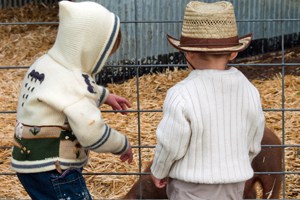UMASH Co-Director Matthew Keiffer, MD, MPH has been quoted in a recent AgriView.com publication. In the article, entitled ‘Farms linked to less asthma,

Project Description
View All Funded Pilot Projects
2012-2014
Early farm exposure, including prenatal exposure, is associated with increased mRNA expression of innate immune receptors (TLR2, TLR4, CD14) in peripheral blood mononuclear cells (PBMC). Moreover, epidemiologic studies from multiple continents have found rural farming environments are protective for development of allergic diseases, with a proposed mechanism of skewing toward proinflammatory cytokine responses.
One potential explanation for these findings is that pre- and post-natal stimulation of the innate immune system is necessary for optimal immune maturation. Cross-sectional studies on cord blood of term newborns found both pre- and post-natal environmental exposures are significantly associated with unique patterns of immunologic responses. Specifically, the immune response of infants born into farming environments is associated with increased production of proinflammatory cytokines determined from in vitro culture supernatants after culture with TLR agonists. We have unpublished data showing that Wisconsin farm children in the Marshfield Epidemiology Research Area (MESA) are at significantly lower risk for developing allergic disease and clinically significant respiratory viral illnesses. To date, an immunologic profile that allows protection from clinically significant illnesses has not been defined nor has the TLR-mediated cytokine response been characterized at the cellular level in infants from farming environments.
UPDATE 2015:
Our large NIH grant is in its third year of funding. We have reached 75% of our enrollment goal. We have submitted separate proposals to fund the microbiome analysis (pending) and will submit competitive renewal to the NIH to continue to follow this important and unique birth cohort.
Wisconsin farm children in the Marshfield Epidemiology Research Area (MESA) are at significantly lower risk for developing allergic disease and clinically significant respiratory viral illnesses.
Project News


UMASH Research Featured in AgriView.com Article on Asthma and Allergies

UMASH Research Group Awarded $5 Million NIH Grant
Dr. Christine Seroogy, Principal Investigator of the pilot project “Exploratory Immunologic Differences in Cord Blood from Infants Born into Farming

 Our research group has been awarded a $5 million NIH award to continue this work with a larger number of infants and in a prospective manner. In addition to monitoring immune maturation, this larger study will monitor respiratory infection frequency and severity, development of allergic diseases (for example, atopic dermatitis), and collection of individual and environmental samples for future microbiome analysis.
Our research group has been awarded a $5 million NIH award to continue this work with a larger number of infants and in a prospective manner. In addition to monitoring immune maturation, this larger study will monitor respiratory infection frequency and severity, development of allergic diseases (for example, atopic dermatitis), and collection of individual and environmental samples for future microbiome analysis.

